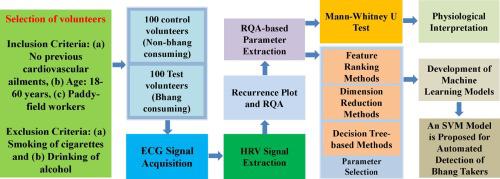IRBM ( IF 4.8 ) Pub Date : 2020-11-18 , DOI: 10.1016/j.irbm.2020.11.001 S.K. Nayak , K.K. Tarafdar , S. Banani , I. Banerjee , D. Kim , K. Pal

|
Objective
In the last few decades, the consumption of cannabis-based products for recreational purposes has dramatically increased. Unfortunately, cannabis consumption has been associated with the incidences of cardiovascular diseases. Hence, there is a necessity for understanding the plausible mechanics of cardiophysiological changes due to cannabis consumption. Accordingly, the current study was designed to understand the suitability of the recurrence quantification analysis (RQA) method in detecting the changes in the heart rate variability (HRV) time-series signals due to the consumption of cannabis (bhang). Further, a machine learning model has been proposed for the automated detection of the cannabis takers.
Materials and Methods
The RQA of the HRV time-series signals from 200 healthy Indian male paddy-field workers were carried out. The obtained parameters were statistically analyzed using the Mann-Whitney U test. Further, the decision trees, weight-based feature ranking, and dimensionality reduction methods were employed for identifying the relevant features for the development of a suitable machine learning model.
Results
Observable changes in the patterns of the recurrence plots among the bhang consuming and non-consuming groups were noticed. However, there were no significant differences in the RQA parameters. Among the developed machine learning models, the SVM model obtained from the “Information gain ratio” feature selection method exhibited the highest accuracy (%) of 69.09 ± 9.33.
Conclusion
Our study suggests that the RQA method is not as effective as the time and frequency domain methods for detecting the alterations in the HRV time-series signals due to cannabis consumption. The SVM model was found to be the best model for the automated detection of cannabis takers. The selection of the features by the information gain ratio method played an important role in the development of the optimized SVM model.
中文翻译:

通过递归量化分析比较从食用大麻和不食用大麻的印度稻田工人获得的 HRV 时间序列信号
客观的
在过去的几十年里,用于娱乐目的的大麻产品消费量急剧增加。不幸的是,大麻消费与心血管疾病的发病率有关。因此,有必要了解大麻消费引起的心脏生理变化的合理机制。因此,目前的研究旨在了解复发量化分析 (RQA) 方法在检测由于大麻 (bhang) 消费引起的心率变异性 (HRV) 时间序列信号变化方面的适用性。此外,还提出了一种机器学习模型来自动检测吸食大麻者。
材料和方法
对来自 200 名健康的印度男性稻田工人的 HRV 时间序列信号进行了 RQA。使用 Mann-Whitney U 检验对获得的参数进行统计分析。此外,决策树、基于权重的特征排序和降维方法被用于识别相关特征,以开发合适的机器学习模型。
结果
注意到 bhang 消耗组和非消耗组的循环图模式的可观察变化。但是,RQA 参数没有显着差异。在已开发的机器学习模型中,通过“信息增益比”特征选择方法获得的 SVM 模型表现出最高的准确率 (%),为 69.09 ± 9.33。
结论
我们的研究表明,在检测由于大麻消费引起的 HRV 时间序列信号变化方面,RQA 方法不如时域和频域方法有效。SVM 模型被发现是自动检测大麻吸食者的最佳模型。信息增益比方法的特征选择在优化SVM模型的开发中发挥了重要作用。



























 京公网安备 11010802027423号
京公网安备 11010802027423号